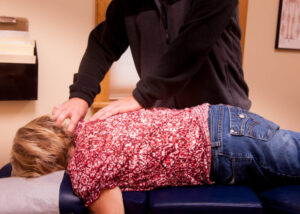Words to Know in the Chiropractic Office

 Familiarize yourself with the following terms that you may encounter during your office visit at Acupractic Natural Healing, office of Dr. Lisa Oskardmay
Familiarize yourself with the following terms that you may encounter during your office visit at Acupractic Natural Healing, office of Dr. Lisa Oskardmay
- Activator Technique: a chiropractic treatment method using a handheld device created as an alternative to manual manipulation of the spine or extremity joints.
- Acute: severe conditions, illnesses or injuries that need immediate care.
- Adjustment: a standard method for chiropractors to treat back pain and neck pain and involves the application of specific thrusts of varying speed and forces to spinal joints that are causing dysfunction and related pain.
- Alternative Medicine: any of a range of medical therapies that are not regarded as orthodox by the medical profession, such as herbalism, homeopathy, chiropractic, and acupuncture.
- Arthritis: painful inflammation and stiffness of the joints.
- Bone spur: A bone spur (osteophyte) is a bony growth formed on normal bone.
- Cervical: relating to the neck.
- Chiropractor: a health care professional focused on the diagnosis and treatment of neuromuscular disorders, with an emphasis on therapy through manual adjustment and manipulation of the spine.
- Chronic: (of an illness) persisting for a long time or regularly recurring.
- Coccyx: a small triangular bone at the base of the spinal column in humans and some apes, formed of fused vestigial vertebrae.
- Complimentary Medicine: any of a range of medical therapies that fall beyond the scope of scientific medicine but may be used alongside it in the treatment of disease and ill health. Examples include acupuncture, chiropractic, and osteopathy.
- Disc: the shock-absorbing structure between each vertebra.
- Diversified Technique: chiropractic adjusting technique involving very precise hands-on thrusts aimed at restoring proper movement and alignment to the spine.
- Extremity: a limb of the body especially: a human hand or foot.
- Facet: small stabilizing joints located between and behind adjacent vertebrae.
- Fixation: an altered position of the vertebra and subsequent functional loss, which determines the location for spinal adjustment.
- Health: the state of being free from illness or injury.
- Hypermobility: s a connective tissue disease characterized by joint instability, chronic pain, and minor skin changes.
- Hyperlordosis: when the inward curve of the spine in the lower back is exaggerated. This condition is also called swayback or Saddleback.
- Hypomobility: a decrease in the normal movement of a joint or body part, as may result from an articular surface dysfunction or from disease or injury that affects a bone, muscle, or joint.
- Ilium: the uppermost and most significant part of the hip bone, and appears in most vertebrates including mammals and birds, but not bony fish.
- Inflammation: part of the complex biological response of body tissues to harmful stimuli, such as pathogens, damaged cells, or irritants, and is a protective response involving immune cells, blood vessels, and molecular mediators.
- Intervertebral Foramen: any of the openings that give passage to the spinal nerves from the vertebral canal and are formed by the juxtaposition of superior and inferior notches in the pedicles of contiguous vertebrae.
- Kinetic Chain: body joints and segments that affect one another during movement.
- Kyphosis: excessive outward curvature of the spine, causing hunching of the back.
- Lordosis: excessive inward curvature of the spine.
- Lumbar: relating to the lower part of the back.
- Nerve: a whitish fiber or bundle of fibers that transmits impulses of sensation to the brain or spinal cord, and impulses from these to the muscles and organs.
- Occipital: relating to or situated in the back of the head.
- Range of Motion: a measurement of movement around a joint.
- Report of Findings: The results section of patient history and examination.
- Sacrum: a triangular bone in the lower back formed from fused vertebrae and situated between the two hipbones of the pelvis.
- Sciatica: pain affecting the back, hip, and outer side of the leg, caused by compression of a spinal nerve root in the lower back, often owing to degeneration of an intervertebral disk.
- Scoliosis: abnormal lateral curvature of the spine.
- Spasm: involuntary muscular contraction or convulsive movement.
- Spinous Process: a bony projection off the posterior (back) of each vertebra.
- Stress: a state of mental or emotional strain or tension resulting from adverse or very demanding circumstances.
- Subluxation: a spinal vertebra that is out of position in comparison to the other vertebrae, possibly resulting in functional loss.
- Thoracic: the back; each of the twelve bones of the backbone to which the ribs are attached.
- Transverse Process: a small bony projection off the right and left side of each vertebra.
- Treatment Plan: a written document that outlines the progression of therapy. It will be used by you and your therapist to direct the steps to take in treating whatever you’re working on.
- Vertebra: each of the series of small bones forming the backbone, having several projections for articulation and muscle attachment, and a hole through which the spinal cord passes.
- Vertebral Subluxation: A lesion or dysfunction in a joint or motion segment in which alignment, movement integrity and/or physiological function are altered, although contact between joint surfaces remains intact.
- Wellness: the state of being in good health, especially as an actively pursued goal.
- Whiplash: injury caused by a severe jerk to the head, typically in a motor vehicle accident.